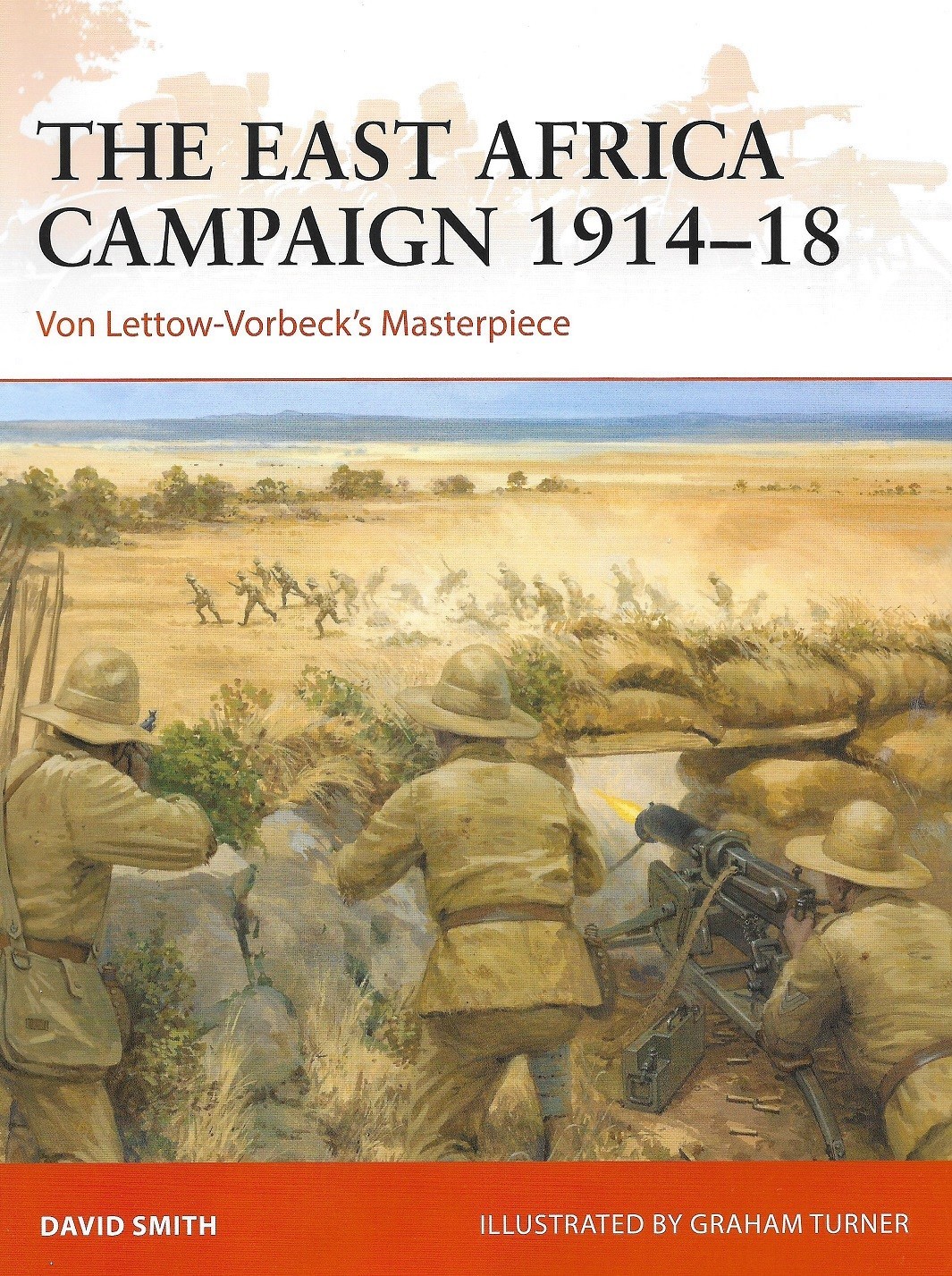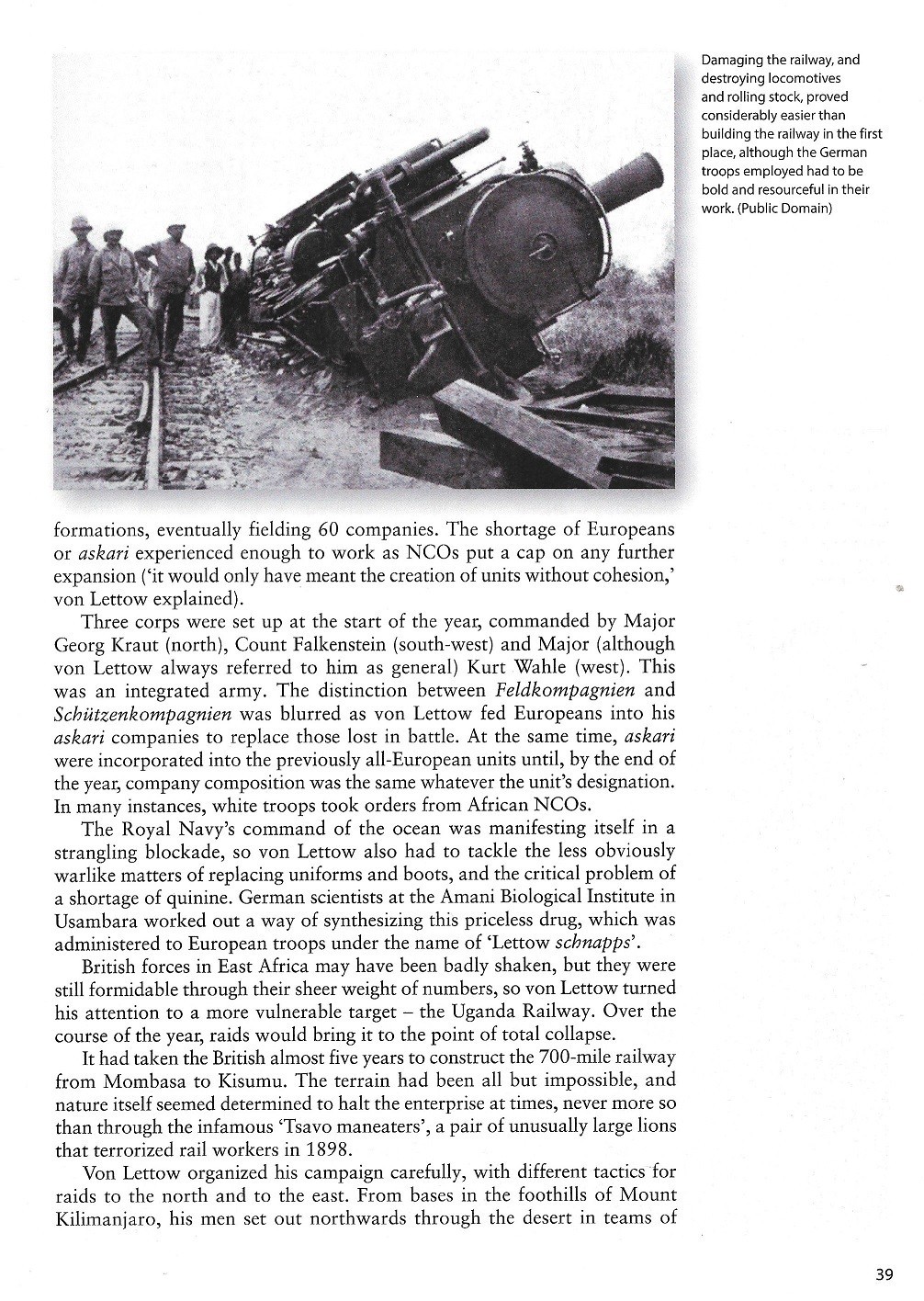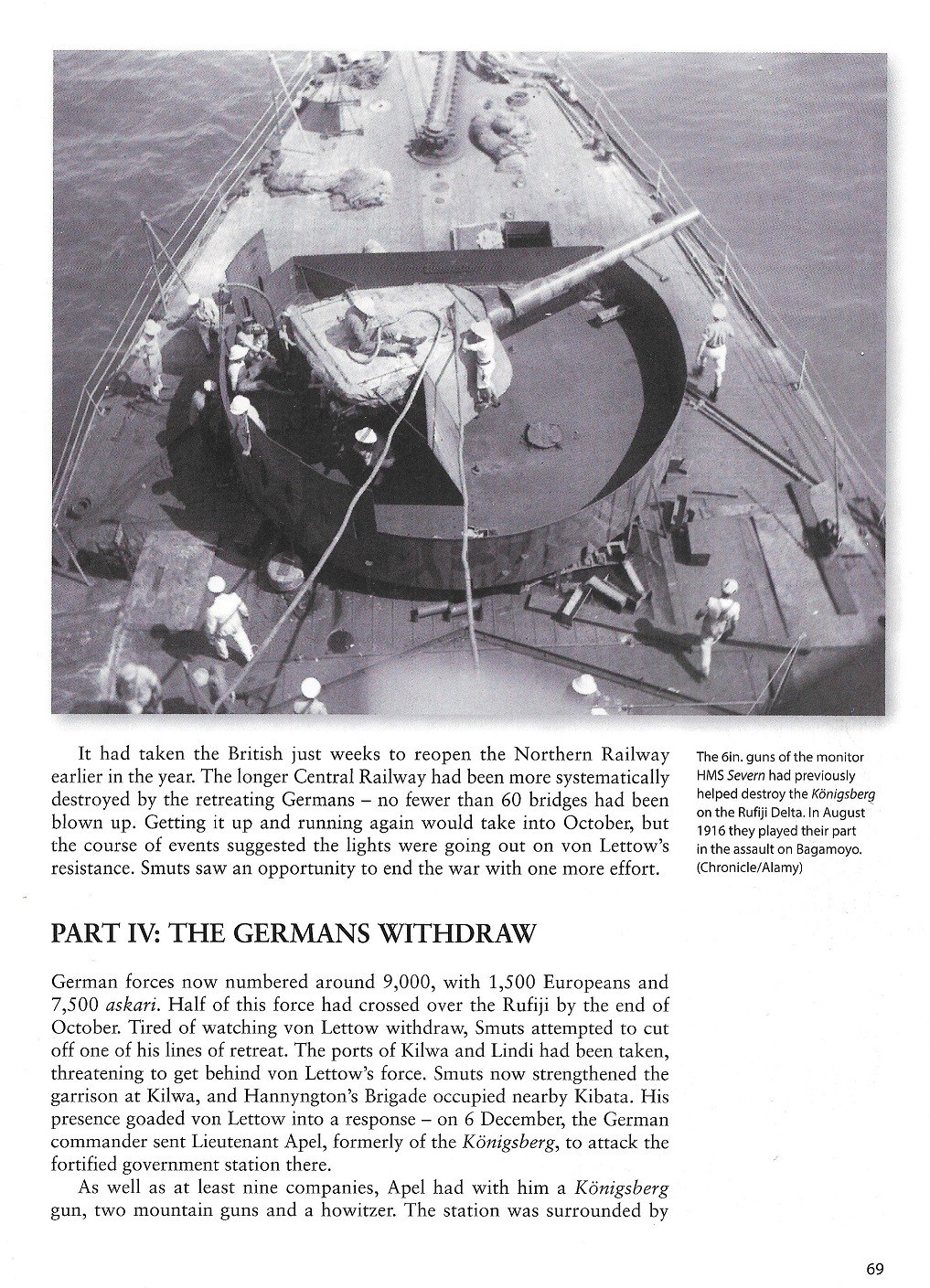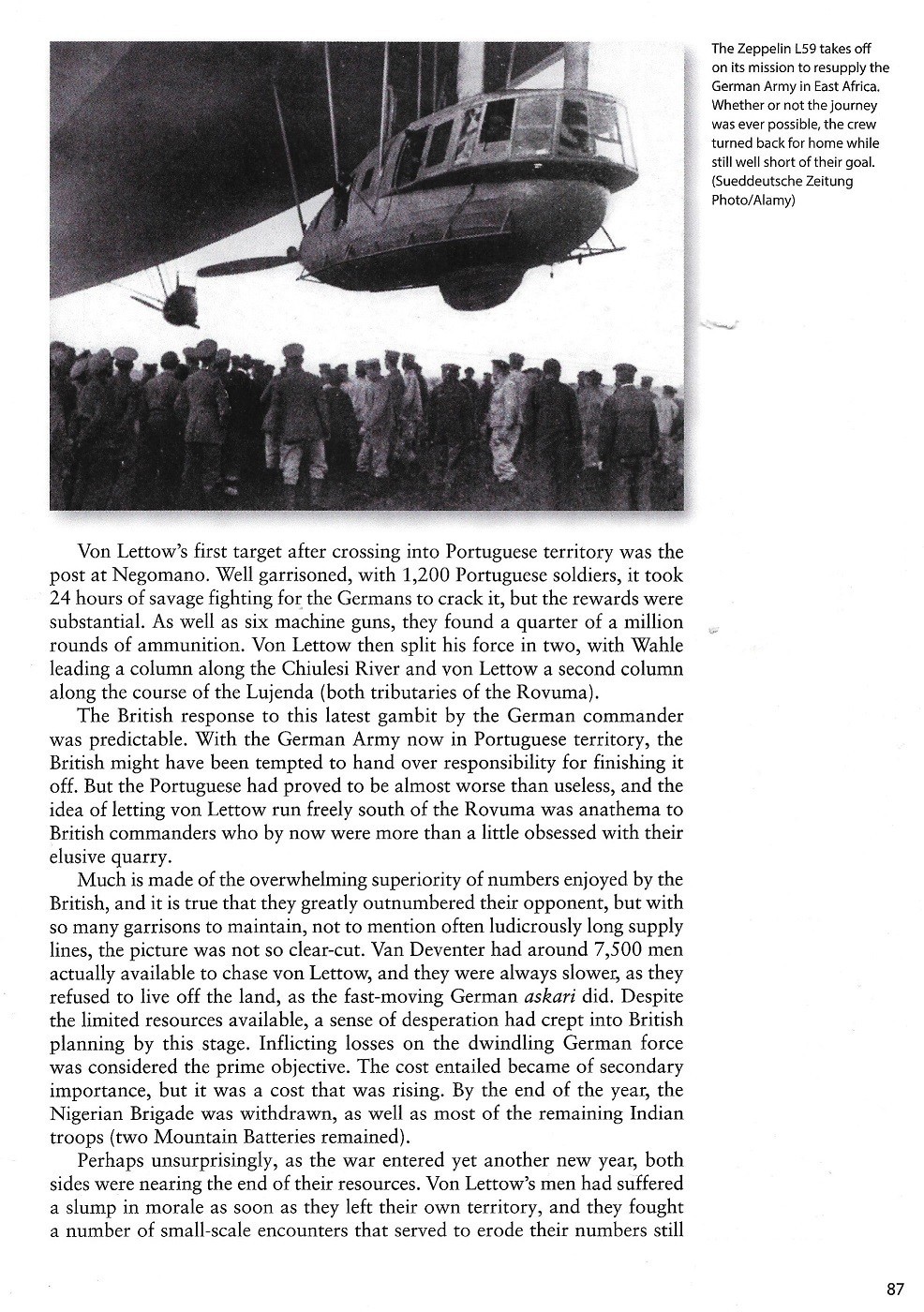HISTORY:
** The East African Campaign in World War I consisted of a series of battle and guerilla actions which began in German East Africa in 1914 and spread to portions of Portuguese Mozambique, northern Rhodesia, British East Africa, the Uganda Protectorate, and the Belgian Congo, German colonial forces under Lieutenant-Colonel Paul von Lettow-Vorbeck attempted to divert Allied forces from the Western Front. Despite the efforts of the Allied forces, Lettow-Vorbeck’s troops remained undefeated at the end of the war.
In this fascinating work, David Smith documents how a wide array of British, Indian, South African, Belgian, Portuguese and local native forces invaded German East Africa and slowly ousted the German forces, a process made tortuous by Lettow-Vorbeck’s masterful management of tactics and movement. Among the events covered are the Battle of Tanga, the scuttling of the Königsberg, the German railway campaign, and the battles at Salaita Hill, Kondoa-Irangi, Mahenge, Mahiwa and Namacurra. Colourful period and specially commissioned illustrations bring to life a wide-ranging and eventful campaign in which a high price was extracted for every inch of ground given up. **
** Quoted from the back cover of the book.
THE BOOK:
Osprey Publications has released The East Africa Campaign 1914–18, Von Lettow-Vorbeck’s Masterpiece as Number 379 in the Campaign series. It is a 96-page soft cover book. Included with the text are black and white photographs, color illustrations, maps, 3-dimensional ‘bird’s-eye-views’, detailed captions and more. It has a 2022 copyright, a publication date of June 23, 2022 and the ISBN is 978-1-4728-4891-8.
THE CONTENTS:
- Origins of the Campaign
- Chronology
- Opposing Commanders
- British
- German
- South African
- Opposing Forces
- Orders of Battle
- Opposing Plans
- The East African Campaign
- Part I: The British offensive
- Part II: The railway war
- Part III: The South African offensive
- Part IV: The Germans withdraw
- Part V: The final stage
- Aftermath
- The Battlefields Today
- Further Reading
- Index
THE TEXT:
Author David Smith provides a well written text detailing the World War One East Africa campaign during the years of 1914 through 1918. David Smith provides insight from both sides of each conflict giving information such as first-hand accounts from active participants in the fighting, actions taken by both sides as well as the outcome of each battle. David Smith gives a step-by-step narration of each of the battles which with the accompanying maps helps place the reader at the battles and makes it easy for the reader to understand what took place and why with the German tactic of tying up British troops, weapons and supplies to prevent them from being used in Europe and to put a strain on British resources. David Smith details well the German successes and the British errors such as the German tactic of living off the land for resupply which also caused a “scorched earth” type issue for the pursuing British which worked in the German’s favor as opposed to the British relying on supply trains which caused them resupply issues. As well as providing information on the separate incidents, David Smith also details organization, preparation, weapons and equipment used by both sides as well as the fighting techniques of the combatants during the conflicts on the land as well as during the naval conflicts. Along with his own words David Smith has also provided several quotes and first-hand accounts from key individuals providing specific details and pertinent information. The text in the book is nicely written and well detailed and provides a wealth of information in an easy-to-read format. As I read through the text, I didn’t notice any spelling or grammatical errors. Grammar and spelling might not be an important factor to everyone however it is something that I take notice of and pass on my findings. I feel that if the text is well written then it shows that the author has taken the time to be professional with their writing. Anyone wanting to add an excellent reference and history book on the all detailing the World War One East Africa Campaign during the years of 1914 through 1918 to their personal library will be pleased with this informative and interesting book.
THE PHOTOGRAPHS:
A total of 55 black and white photographs and 10 color photographs are included in this volume. Author David Smith stuck to the title of the book and chose subject specific photographs and did not include photographs that strayed from the main subject of the book. The majority of the photographs are clear and easily viewable; however, a few have an out of focus look to them and some appear to be too dark, and others appear too light. This is typical for the discussed period of history and consideration needs to be given to the fact that most of the photographs are over one hundred years old and the quality of the photographs is of no fault of the author and do not take anything away from the book. The photographs range from wide angle photographs to close-up photographs, many of which are studio type portraits of specific individuals. The majority, if not all, of the photographs will prove to be a wealth of information to the scale military modeler as well as anyone interested in World War I conflict on the African continent and the uniforms, weapons and warfare of the discussed period due to the details they contain.
THE ILLUSTRATIONS:
There are three color illustrations by illustrator Graham Turner provided in this volume. All three of the color illustrations are accompanied by a black and white copy of the same illustration on the following page with a well written caption that describes the scene and points out and describes key areas of interest. The illustrations are very well done, nicely detailed and are of:
Plate A
Attack on the Königsberg, 11 July 1915
- A two-page action illustration showing the German light cruiser SS Königsberg under attack by British monitors HMS Mersey and HMS Severn in the Rufiji Delta.
Plate B
The Assault on Salaita Hill
- A two-page action illustration showing troops of the 5th, 6th and 7th South African Infantry assaulting the German positions on Salaita Hill, which is also being shelled by British artillery.
Plate C
The 25th Royal Fusiliers at Mahiwa
- A two-page action illustration showing men of the 25th Fusiliers coming under fire from a German machine position. A portion of this illustration is used on the front cover of the book.
‘BIRD’S-EYE-VIEWS’:
There are 2 Bird’s-Eye-View’ maps included in this volume and they are:
- Battle of Tanga, Second Day, 4 November 1914
- The Nigerians at Mahiwa, 15-16 October 1916
THE CAPTIONS:
The captions are well written and explain the accompanying photographs and illustrations in great detail eliminating any doubt as to what is shown. The captions go into very specific detail as to specific individual’s names, dates, locations and other such pertinent information. As I read through the captions, I didn’t notice any spelling errors or grammatical errors. I was impressed by David Smith’s captions as they are very helpful to the reader due to their detailed content as opposed to other captions that I have seen that are very brief and lacking in detail.
MAPS:
There are 7 color maps included in this volume that are accompanied by well written captions and detailed keys that point out specific locations as well as movements and actions by both sides of each conflict.
The maps are of:
- European colonies in Africa, 1914
- German East Africa, north of the Rufiji, 1914
- Hunting the Königsberg
- The Assault on Salaita Hill, 12 February 1916
- The 1916 offensive
- The 1917 offensive
- Von Lettow-Vorbeck in Portuguese East Africa
CHARTS:
There is 1 chart included in this volume and it is of:
- Key to military symbols
- Key to unit identification
NOTES:
There is 1 note included in this volume and it is:
- Artist’s note
Osprey Publishing also offers The East Africa Campaign 1914–18, Von Lettow-Vorbeck’s Masterpiece as:
eBook (ePub) ISBN: 978-1-4728- 4892-5
and
eBook (PDF) ISBN: 978-1-4728- 4893-2
The East Africa Campaign 1914–18, Von Lettow-Vorbeck’s Masterpiece is also available as an electronic Kindle version through Amazon.com.
PRICE:
UK £15.99 / US $24.00 / CAN $32.00
This book was provided to me by Osprey Publishing. Please be sure to mention that you saw the book reviewed here on the KitMaker Network when you make your purchase. Thank you.

































